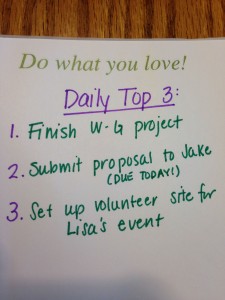Today begins the last week of September, which means we’re heading into the final quarter of the year. What do you want to make happen before 2017 wraps up?
Maybe you have numerous goals, or maybe just one with several moving parts. Either way, now – before the holiday hustle and bustle begins – is a great time to kick things into high gear.
Do you feel ready?
Or overwhelmed?
If you’re ready – go for it! Watch my blog a bit later this week for a tool that will help ensure you do what you set out to.
And if you’re not quite sure what to do next or feel overwhelmed by it all, start with two questions:
1. What do you most want to say about yourself at the end of the year?
2.Which one goal, if achieved, would complete – or propel forward – several other goals?
The first question will focus your attention on what matters most at this time.
The second question will reveal what I call your Breakthrough Goal.
Your Breakthrough Goal
Essentially, your Breakthrough Goal is the one that, if completed, elevates progress on several other goals or desires at the same time. Rather than slowly moving the various chess pieces forward one at a time (a tactic that often works well when time allows, like at the start of a new year), your Breakthrough Goal is like the one move that catapults you – keeping to the chess metaphor – toward checkmating your opponent.
Even if all your other pieces still remain on the chess board.
For example, a new client of mine sought out coaching in part because he hadn’t progressed on his 2017 goals as hoped. Now, with year-end approaching, he’s beginning to worry.
At the start of our partnership I asked about his goals, and he had set several: start his own consulting business within his current field (which he loved), begin a blog of helpful tips in his often-complex industry, publish an article in a trade publication, start a speaking career on the side, and various personal goals as well.
I asked him question #1 above, to which he responded, “To be honest, the writing piece is huge for me. For years I’ve said I want to start a blog, publish articles, and eventually write a book. I’d love to end the year able to say I wrote something for the public.”
Question #2 brought him an interesting ‘aha moment’: “Actually, if I started a blog, I would get writing practice as well as potentially get noticed by my trade publication. It could also position me as a thought leader in my field, which would help get my consulting practice and speaking work off the ground. The blog would set the foundation for everything else. And even just publishing one blog post would allow me to say I wrote something for the public!”
Guess where he has decided to focus his energy?
Maybe, like my client, you have several goals to accomplish and need to put them in a manageable order. Or perhaps you’ve got just one goal but it really needs a boost. Either way, try asking yourself those two clarifying questions: What do you most want to say about yourself at the end of the year? Which one goal, if achieved, would complete – or propel forward – several other goals?
Get clear on your top priority outcome for the remainder of the year, and you’ll likely find your motivation improving, your next best action becoming clear, and your momentum building. Then, tune in to this blog a bit later this week for one of the best tools I know to make your goal achievable!
Want help determining what matters most and how to prioritize it in your work, leadership, and life? Join us at Spark on Nov 3 – click here for details!







